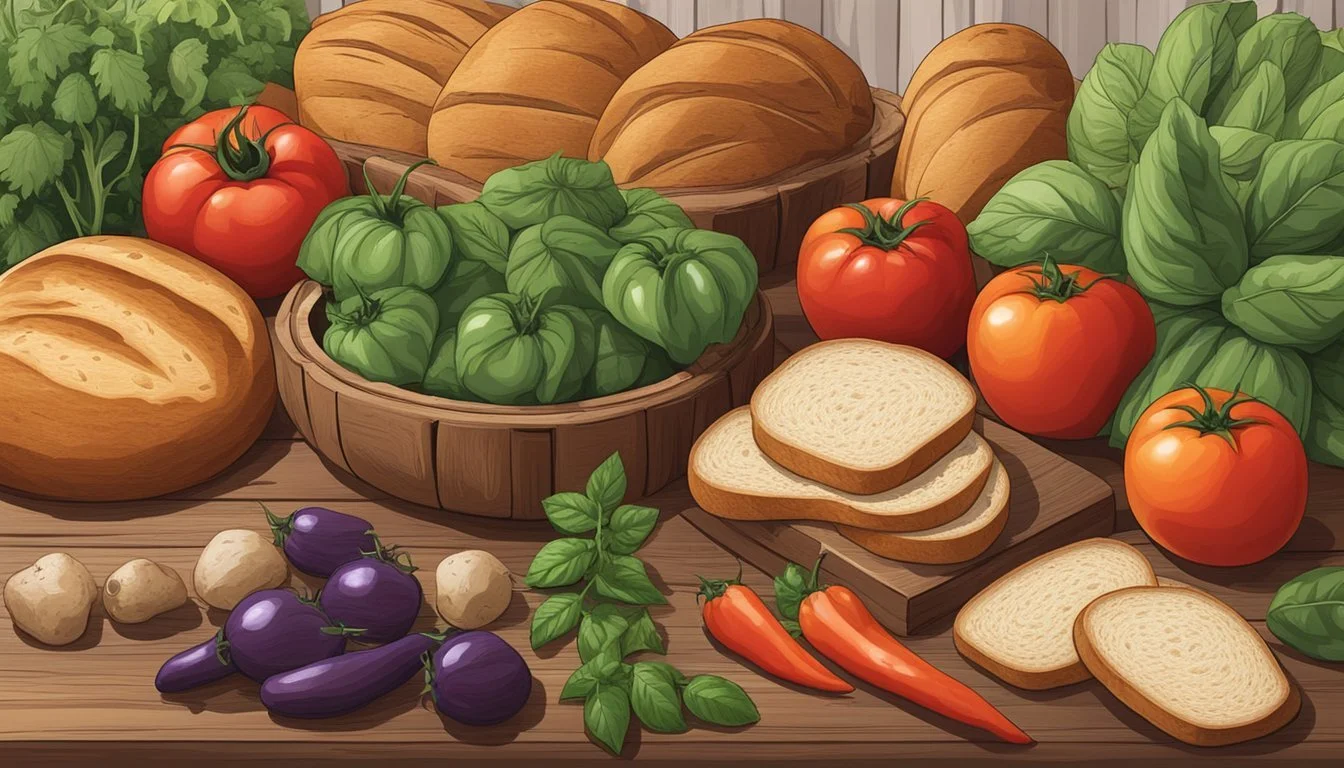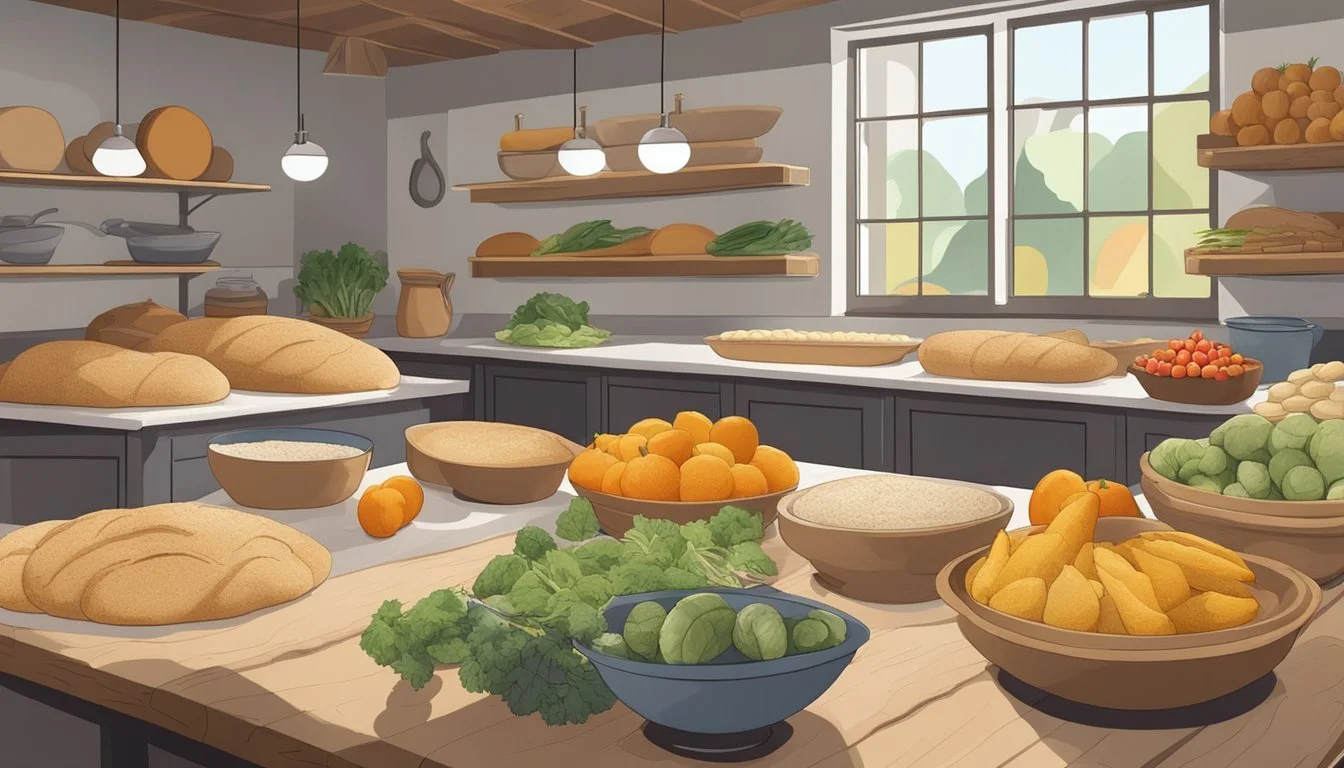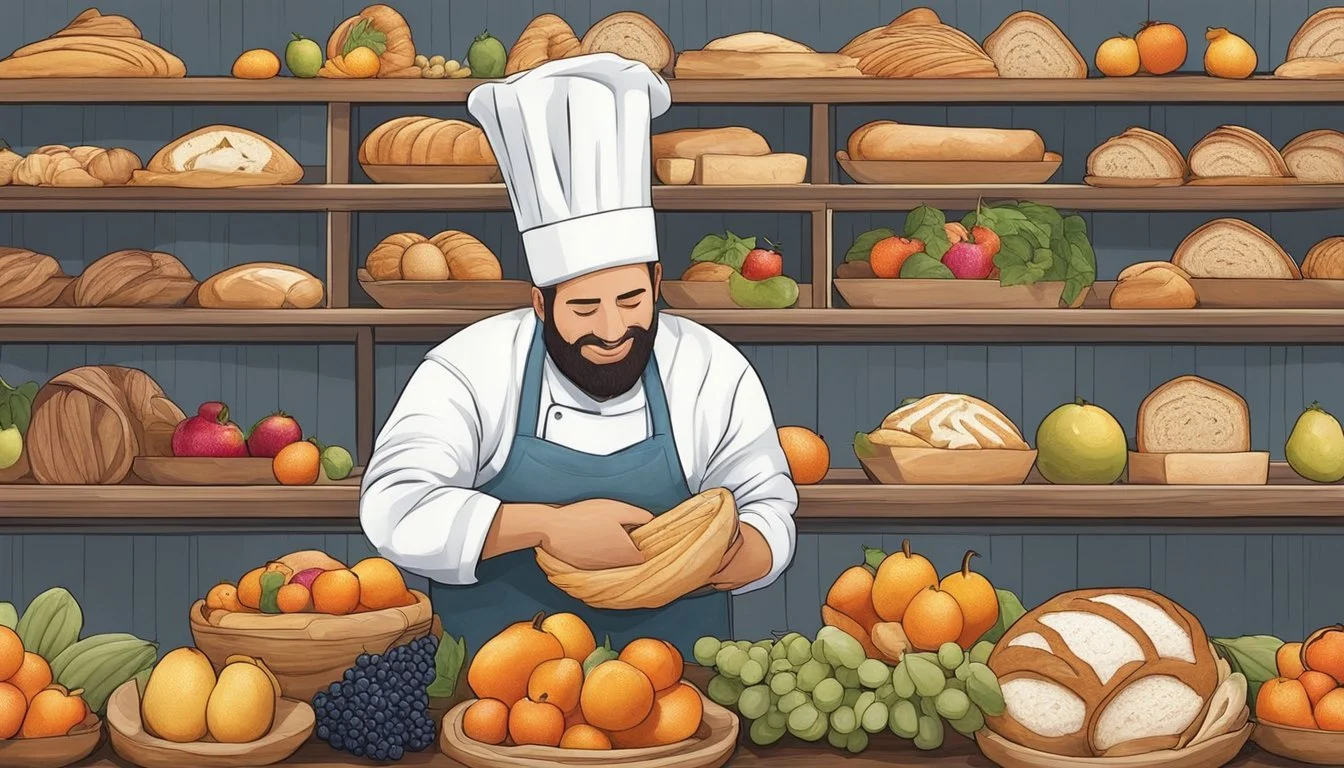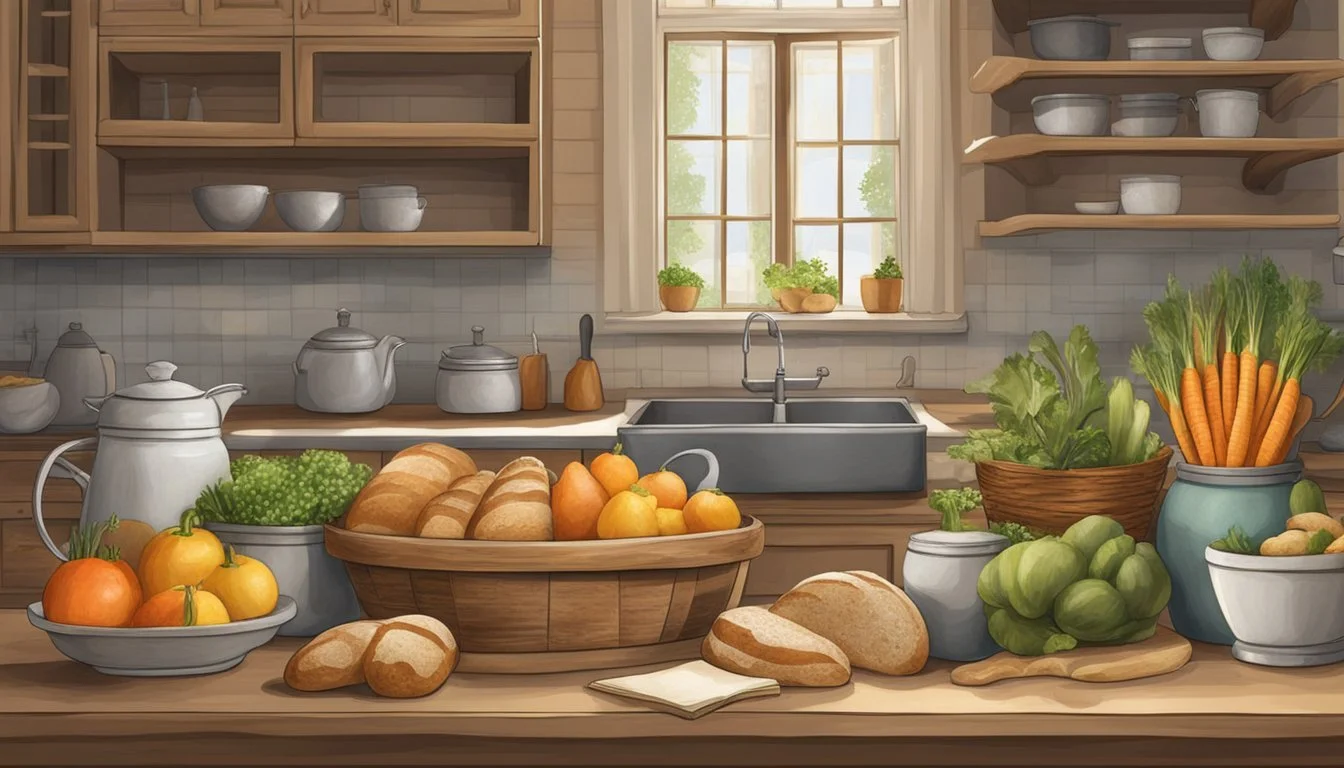Seasonal Sourdough
Fresh Produce Recipes for Artisanal Breads
Sourdough bread (What wine goes well with bread?), with its characteristic tang and chewy texture, has been a staple in artisanal baking for centuries. Its popularity has surged in recent years, with enthusiasts seeking to elevate their homemade loaves through experimentation and new techniques. Incorporating fresh produce into sourdough bread offers bakers a creative way to infuse seasonal flavors and additional nutritional value into their creations.
Crafting sourdough with seasonal produce begins with understanding the sourdough process, which relies on the fermentation of dough using naturally occurring lactobacilli and yeast. This not only develops the complex flavor profile but also aids in the breakdown of gluten, making the nutrients more accessible. When fresh produce is added, it can alter the moisture content and fermentation rate, therefore, bakers must adapt their recipes and techniques to these variations.
Melding fresh ingredients into sourdough can transform the texture, taste, and appearance of the bread. Seasonal fruits, vegetables, and herbs offer a palette of flavors that can complement or enhance the sourness of the bread. They also contribute unique antioxidants, fibers, and vitamins, while the fermentation process can amplify the bioavailability of these nutrients, offering a wholesome, flavor-packed experience with each loaf.
The Basics of Sourdough Bread
The allure of sourdough bread lies in its tangy flavor, chewy texture, and crisp crust, all resulting from the fermentation of the dough by natural yeast and bacteria. The creation of sourdough bread is an art that relies on time-honored techniques and a few key ingredients.
Understanding Sourdough Starter
A sourdough starter is the heart of sourdough bread, consisting of a mixture of flour and water that has been allowed to ferment naturally. This fermentation process is facilitated by wild yeast and lactobacilli bacteria present in the environment, which cultivate over time to create a robust culture. The starter must be regularly "fed" with fresh flour and water to maintain its activity and strength.
Key Components of a Starter:
Flour: Provides nutrients for the yeast and bacteria.
Water: Hydrates flour and aids in the fermentation process.
Wild Yeast: Naturally occurring yeasts that cause dough to rise.
Lactobacilli Bacteria: Bacteria that produce lactic acid, contributing to the sour flavor.
Key Ingredients for Sourdough
In addition to the starter, making sourdough bread requires only a handful of ingredients. Here they are listed in order of necessity:
Flour: The primary structure of bread; typically, a high-protein flour like bread flour is used for its strong gluten network.
Water: Adjusts dough consistency and hydration level, which can affect the bread’s texture.
Salt: Enhances flavor and controls yeast fermentation rate.
Levain: Often a portion of the mature starter is mixed with additional flour and water to create this 'offspring' mixture, used to leaven the bread.
Choosing high-quality ingredients greatly influences the final taste, aroma, and texture of the bread.
Fundamentals of Fermentation
Fermentation is the step where the magic happens in sourdough bread making. During this stage, the starter or levain breaks down the starches in the flour into sugars, which the yeast and bacteria then consume, producing carbon dioxide, alcohol, and organic acids. The carbon dioxide causes the dough to rise, while the organic acids impart the characteristic sour taste.
The Stages of Fermentation:
Bulk Fermentation: This initial phase is when the mixed dough is left to rise, typically for several hours.
Proofing: After the dough is shaped into loaves, it undergoes a final rise before baking.
Temperature Impact on Fermentation:
Warmer Temperatures: Speed up fermentation, leading to a quicker rise.
Cooler Temperatures: Slow down fermentation, allowing for more complex flavors to develop.
Mastery of these fundamental steps and ingredients empowers bakers to produce consistent and flavorful sourdough bread.
Preparing Your Dough
When incorporating fresh produce into sourdough, precise dough preparation is crucial. Proper mixing, kneading, and fermentation set the stage for a flavorful and well-structured loaf.
Mixing and Autolyse
Mixing the dough begins with combining flour, water, sourdough starter, and any pureed or finely chopped fresh produce. During this stage, it's important to distribute the starter and produce evenly throughout the flour. The autolyse process involves letting the mixture rest:
Time: Typically 20 to 60 minutes
Purpose: Allows flour to absorb water, enzymes to start breaking down starch into sugars, and gluten development to begin
No salt or additional ingredients are added during autolyse to ensure full hydration and initial gluten formation.
Kneading and Gluten Development
Kneading further develops the gluten structure, essential for trapping gases produced during fermentation. Achieving a strong gluten network is critical when adding fresh produce, which can interfere with gluten bonds. For hand kneading:
Duration: Approximately 10 to 20 minutes
Technique: Stretch and fold the dough until it becomes more elastic and less sticky
This step may vary depending on the type of produce and hydration level of the dough.
Bulk Fermentation Explained
Bulk Fermentation refers to the critical phase where the dough is left to rise until it has doubled in size. It should display multiple air bubbles and have an increased volume. Factors to monitor include:
Temperature: Keep the dough in a warm, draft-free area
Time: Can range from 4 to 12 hours depending on ambient temperature and dough composition
Proper bulk fermentation ensures that the dough develops flavor complexity and a good crumb structure, accommodating the fresh produce without compromising the loaf's integrity.
Shaping and Proofing
Proper shaping and proofing are essential to developing the texture and structure of sourdough bread. Mastery of these techniques influences the gluten strands' alignment and the final loaf's open crumb.
Creating Tension in the Dough
Creating tension in the dough is critical in shaping sourdough loaves. This process aligns the gluten strands, forming a tight skin that contains the gas produced during fermentation and contributes to the bread's final volume. To shape the dough, bakers typically perform a series of stretches and folds, then shape it into the desired form—be it a boule, batard, or any specialty shape—gently but firmly to develop surface tension. It’s important to handle the dough confidently to avoid deflating it, which could detriment the open crumb.
Steps for Tension Creation:
Stretch and Fold: Periodically during bulk fermentation, stretch the dough and fold it over itself.
Shaping: Form the dough into the desired shape using a series of pulls or rolls, sealing the seams well.
Final Shape: Place the shaped dough into a proofing basket (banneton) to hold its form and support the final rising process.
Final Proofing Techniques
Final proofing allows the shaped dough to rise and develop the final crumb structure before baking. The proofing temperature can significantly impact the fermentation rate, with a range between 25-38°C (77-100°F) being ideal for sourdough. A cooler temperature, like 18°C (64°F) and above, will slow down the proofing process but can still produce excellent results—it might just take longer. Look for a smooth surface and a slight springiness upon gentle poking to judge whether the dough has proofed sufficiently.
Considerations for Final Proofing:
Temperature: Maintain an optimal range for steady fermentation.
Time: Allow enough time for the dough to fully rise; this can vary based on kitchen temperature.
Surface: Observe the dough for a taut, smooth surface, indicative of proper gluten development.
Touch Test: Perform a gentle poke test; the dough should slowly spring back, indicating readiness for baking.
By paying attention to shaping and proofing nuances, bakers manipulate gluten development and gas retention, directly affecting the final bread's open crumb and overall quality.
Baking Sourdough Bread
Mastering the bake of sourdough bread involves precise oven setup and equipment to achieve the ideal crust and crumb structure. The following subsections detail the critical steps for setting up an oven with optimal steam and using a Dutch oven for superior baking results.
Oven Setup for Optimal Steam
Steam in the baking environment is crucial for the development of a crispy crust and an appealing rise. Home bakers can create steam by preheating the oven with a baking stone and a pan of water on the bottom rack. As the loaf goes into the oven, boiling water is poured into the preheated pan to generate steam. Oven temperature should be around 450°F (232°C) for the initial bake, before reducing to 375°F (190°C) after steam has been applied. This strategy aids in the expansion of the dough during the initial baking stages, contributing to a well-defined crumb structure.
Using a Dutch Oven for Baking
A Dutch oven retains heat and traps steam released by the dough, which mimics the conditions of a professional bakery oven. To use a Dutch oven for sourdough baking, one must:
Preheat the Dutch oven inside the conventional oven to 500°F (260°C) for at least 30 minutes.
Carefully place the dough into the hot Dutch oven, optionally scoring the top to control where the bread expands.
Cover with the lid to seal in steam and place it back in the oven, reducing the temperature to 450°F (232°C).
Bake with the lid on for 20 minutes, then remove the lid and lower the temperature to 425°F (218°C) to finish baking and develop a golden-brown crust.
Using a Dutch oven encapsulates the loaf in a steamy environment, essential for achieving a bread with a robust crust and a tender, open crumb.
Seasonal Ingredients and Flavor Additions
One can elevate the taste of sourdough bread by incorporating various seasonal ingredients directly into the dough. This intentional blend of fruits, vegetables, nuts, and cheeses can create unique flavor profiles suited to personal preference, whether sweet or savory.
Incorporating Fruits and Vegetables
Seasonal fruits and vegetables can significantly enhance the taste and texture of sourdough bread. For a sweet touch, summer berries or autumnal pumpkin can be folded into the dough. Dried fruits (What wine goes well with dried fruits?) like figs or apricots offer a concentrated burst of flavor and are particularly delightful with nuts and seeds. On the savory side, olives and sundried tomatoes add a Mediterranean flair, while roasted garlic or caramelized onions can give the bread a depth of flavor that is irresistibly rich.
Example Ingredients:
Sweet: Berries, Pumpkin, Dried Fruits
Savory: Olives, Roasted Garlic, Sundried Tomatoes
Using Nuts, Seeds, and Herbs
The addition of nuts and seeds brings a hearty crunch and boosts the nutritional value of the bread. One can choose from a variety of nuts such as walnuts or almonds for a nutty richness, ideal for pairing with cheeses or spices. Seeds like flax, sunflower, or pumpkin seeds should be soaked overnight to ensure they are soft and palatable in the finished loaf. Fresh herbs such as rosemary or thyme not only infuse the bread with aromatic flavors but also add a vibrant pop of color.
Suggested Combinations:
Nuts: Walnuts, Almonds
Seeds: Sunflower Seeds, Pumpkin Seeds
Herbs: Rosemary, Thyme
Pairing Cheeses and Spices
Adding cheese to sourdough creates a tangy, savory dimension that can complement both sweet and savory elements. Feta plays especially well with Mediterranean flavors and can be balanced with spices for a well-rounded taste. Spices have the power to transform the flavor profile of bread - for instance, combining cinnamon and sugar can cater to those with a sweet tooth, while black pepper and cumin may appeal to those favoring a more savory loaf. Such additions should be made carefully to not overpower but rather to complement the bread’s inherent flavor.
Recommended Pairings:
Cheeses: Feta with Rosemary, Cheddar with Walnuts
Spices: Cinnamon with Dried Fruits, Cumin with Seeds
Advanced Sourdough Techniques
In the pursuit of crafting exceptional sourdough bread, advanced techniques such as the Stretch and Fold method, Laminating High-Hydration Doughs, and Creating Specialty Sourdough Breads are essential to enhance texture and flavor. Mastery of these will elevate a baker’s repertoire, introducing more versatility and complexity to their sourdough creations.
Stretch and Fold Method
The Stretch and Fold method is a technique used to develop gluten structure without traditional kneading. A baker will periodically stretch the dough and fold it over itself, typically performing this action several times over during the bulk fermentation. This technique improves the dough's structure, enabling it to trap more gas and air, which results in a lighter loaf with a more open crumb.
Frequency: Every 30 minutes for the first 2 hours of bulk fermentation
Steps: Gently grasp the dough, stretch upward, then fold over towards the center
Laminating High-Hydration Doughs
Laminating involves carefully stretching high-hydration dough into a thin layer and folding it over itself to create layers. It is a method utilized to incorporate air, build strength in wetter doughs, and distribute inclusions evenly, such as fresh produce for flavored sourdough. To laminate dough:
Prepare the workspace: Lightly flour or oil the surface to prevent sticking
Gently stretch: Take care not to tear the dough as it's expanded to a large rectangle
Fold: Fold the dough letter-style to build layers
Creating Specialty Sourdough Breads
Creating specialty sourdough breads involves incorporating different ingredients into the dough to add unique flavors and textures. For example, adding herbs, cheeses, or fresh vegetables can result in savory loaves of bread with a distinct character. This process requires careful consideration of moisture content; too much additional moisture from produce might require adjustments to the hydration of the dough.
Dry inclusions: Seeds, nuts, and dried fruits can be mixed in directly
Wet inclusions: Vegetables or fruits should be prepped to remove excess moisture and added during the lamination to preserve the dough's structure
Troubleshooting and Perfecting Your Craft
Creating the perfect loaf of seasonal sourdough involves a deep understanding of the variables at play. One must ascertain the optimal conditions for dough development and fermentation, adjust to the ever-changing environmental factors, and master the timing of each stage in the sourdough process.
Assessing Dough and Fermentation Issues
When dough does not behave as expected, bakers should examine the flour's protein content and hydration levels. For example:
High-protein flour typically absorbs more water, which can affect the dough's consistency.
A hydration level that is too low or too high can result in either overly dense or excessively slack dough, respectively.
Fine-tuning these aspects can significantly improve dough strength and structure. Bakers may need to adjust their plans based on the particular type of produce they've incorporated into their sourdough, as the water content in fresh fruits and vegetables can also impact dough hydration.
Adapting to Environmental Factors
Environmental factors like temperature and humidity play critical roles in sourdough baking:
Temperature: A warmer spot in the kitchen (ideally between 75°F-80°F) encourages yeast and bacterial activity, improving fermentation.
Humidity: High humidity might necessitate slight reductions in water content to maintain the dough's structure.
By being mindful of these conditions, bakers can prevent common issues such as over-proofing or sluggish fermentation.
The Art of Sourdough Timing
Timing is essential in the art of sourdough baking:
Proofing: Time the proofing stage to ensure the dough has doubled in size without over-fermenting.
Baking: Some breads require a rest period post-baking to complete the cooking process internally; this is especially important for rye-based sourdoughs, which may need up to 24 hours to cool effectively.
By adhering to these rules and keeping a vigilant eye on the clock, bakers can ensure that their sourdough reaches its full potential with well-developed flavors and desirable textures.
Sourdough Recipes and Variations
This section explores a variety of sourdough bread recipes incorporating whole grains and unique ingredients that offer a twist on the traditional sourdough loaf. Each recipe caters to different preferences and dietary needs, ensuring that there is a sourdough variation for everyone.
Classic Sourdough Loaf
The Classic Sourdough Loaf is the foundation of all sourdough baking and encompasses a simple recipe that requires a mature sourdough starter. Essential ingredients include all-purpose or bread flour, which gives the loaf its characteristic chewiness. The key to a successful classic loaf is the fermentation time, providing the bread with its unique tangy flavor.
Ingredients: Sourdough starter, water, all-purpose/bread flour, salt
Method: Mix, bulk ferment, shape, proof, and bake
Baking time: Approximately 20 minutes covered, then 25 minutes uncovered at a reduced temperature for a crusty exterior
Whole Wheat and Specialty Flours
Diversifying traditional recipes, Whole Wheat and Specialty Flours such as rye or spelt can be introduced for a more complex flavor profile and added health benefits. Whole wheat flour contributes to the nutritional content, with more fiber and a denser texture. Recipes may adjust hydration levels to accommodate the different absorption rates of specialty flours.
Selection: Whole wheat, rye, or spelt flour substitutions
Tip: Increase water slightly for whole grain flours to maintain dough hydration
Recipe suggestion: A mix of whole wheat and bread flour for a balanced whole grain sourdough
Innovative Sourdough Creations
Adventurous bakers have paved the way for Innovative Sourdough Creations, incorporating fresh produce and other ingredients to reinvent traditional sourdough. Blueberry, chocolate chip, coffee, and garlic are just a few examples that can enhance the dough. Pumpkin sourdough bread offers a seasonal twist, combining spices and pumpkin purée for a healthy and flavorful loaf.
Fruit additions: Blueberry Sourdough, taking care with hydration levels due to the water content in the fruit
Savory options: Garlic Sourdough Bread, pairing roasted garlic cloves with a robust whole wheat dough
Sweet blends: Chocolate Chip Sourdough, featuring dark chocolate pieces folded into the dough during shaping
Seasonal specialties: Pumpkin Sourdough Bread, incorporating pumpkin puree and spices directly into the dough
Note: When adding wet ingredients like fruits or vegetables, it is advisable to adjust the dough's hydration to achieve the desired consistency.









